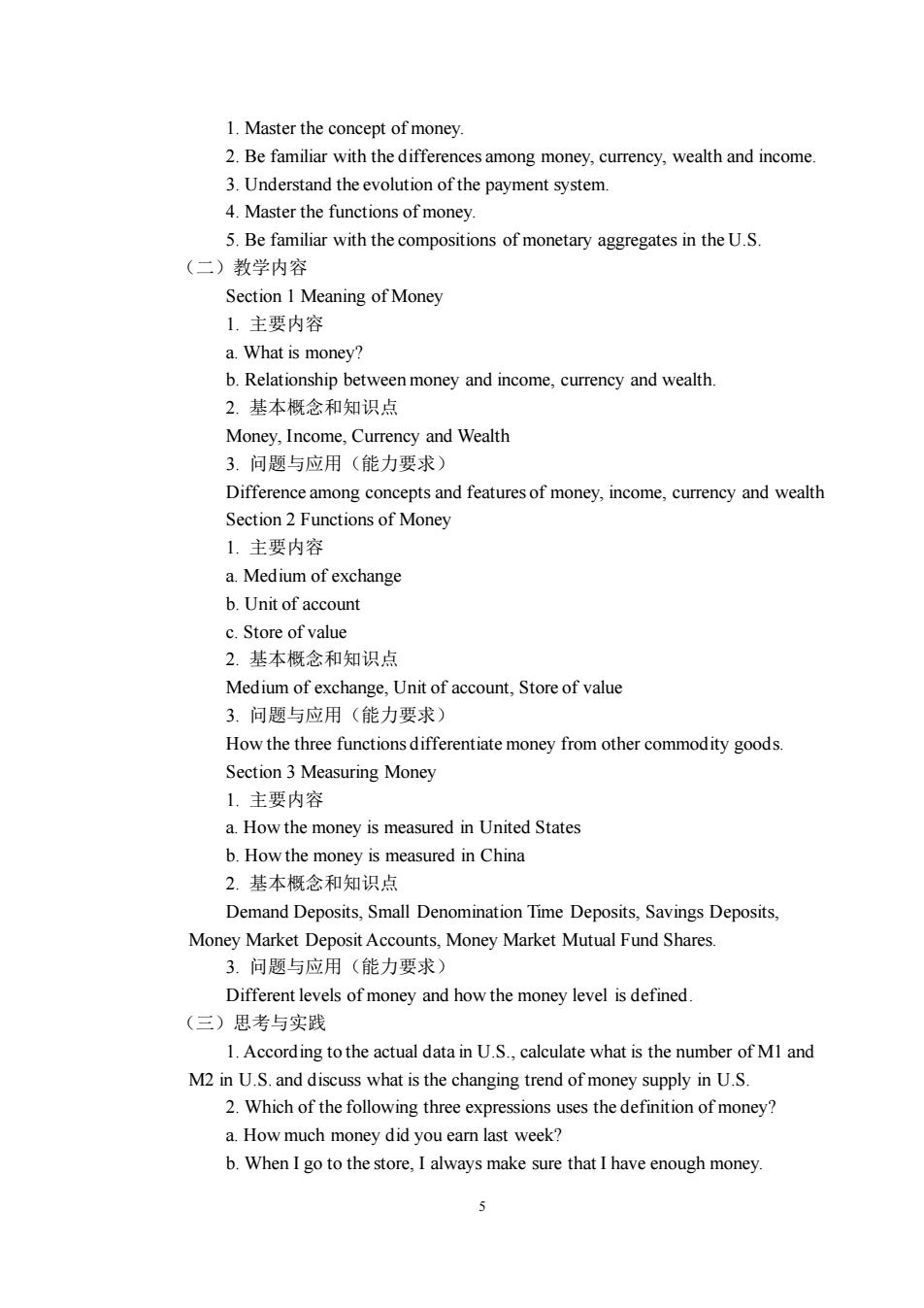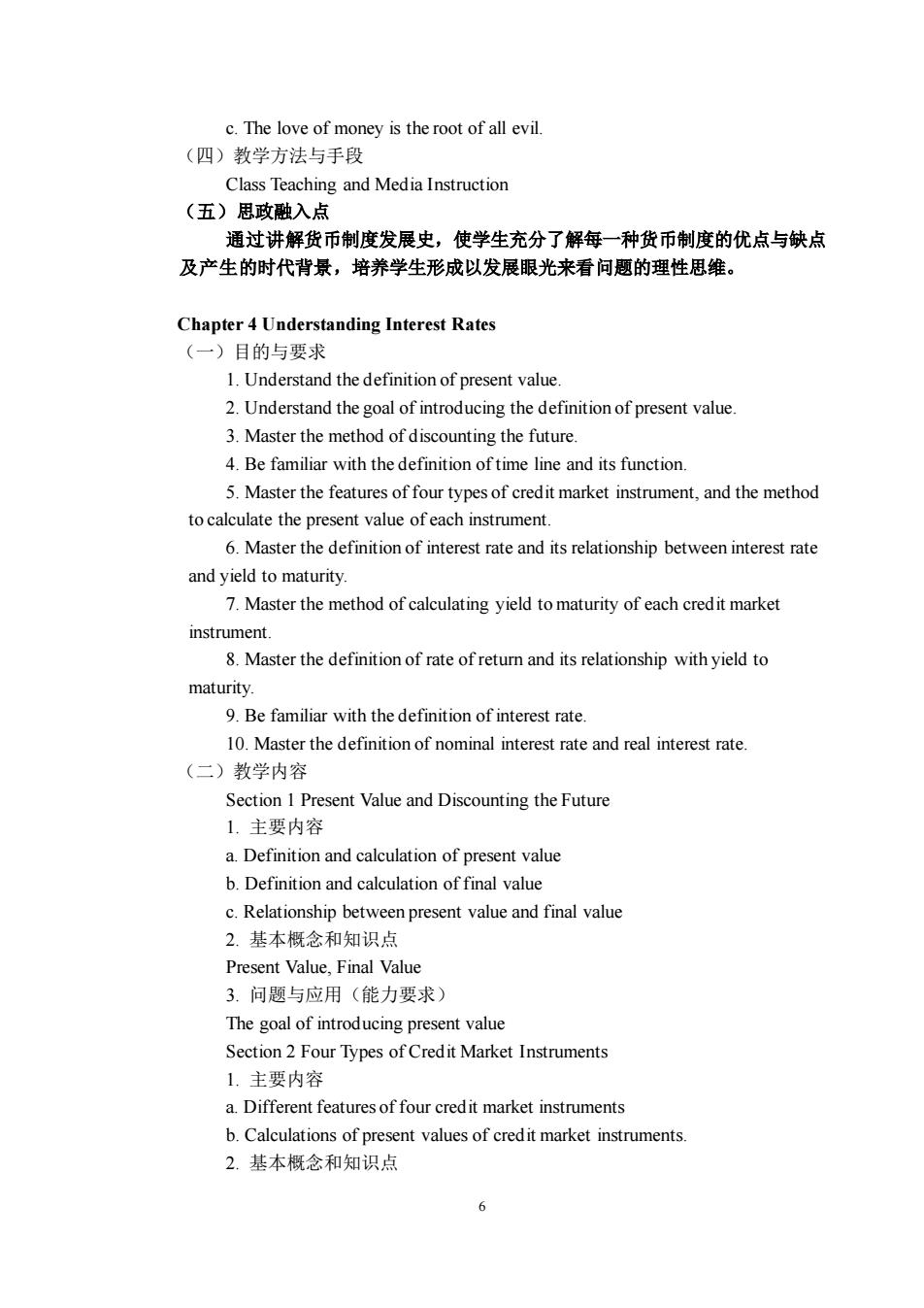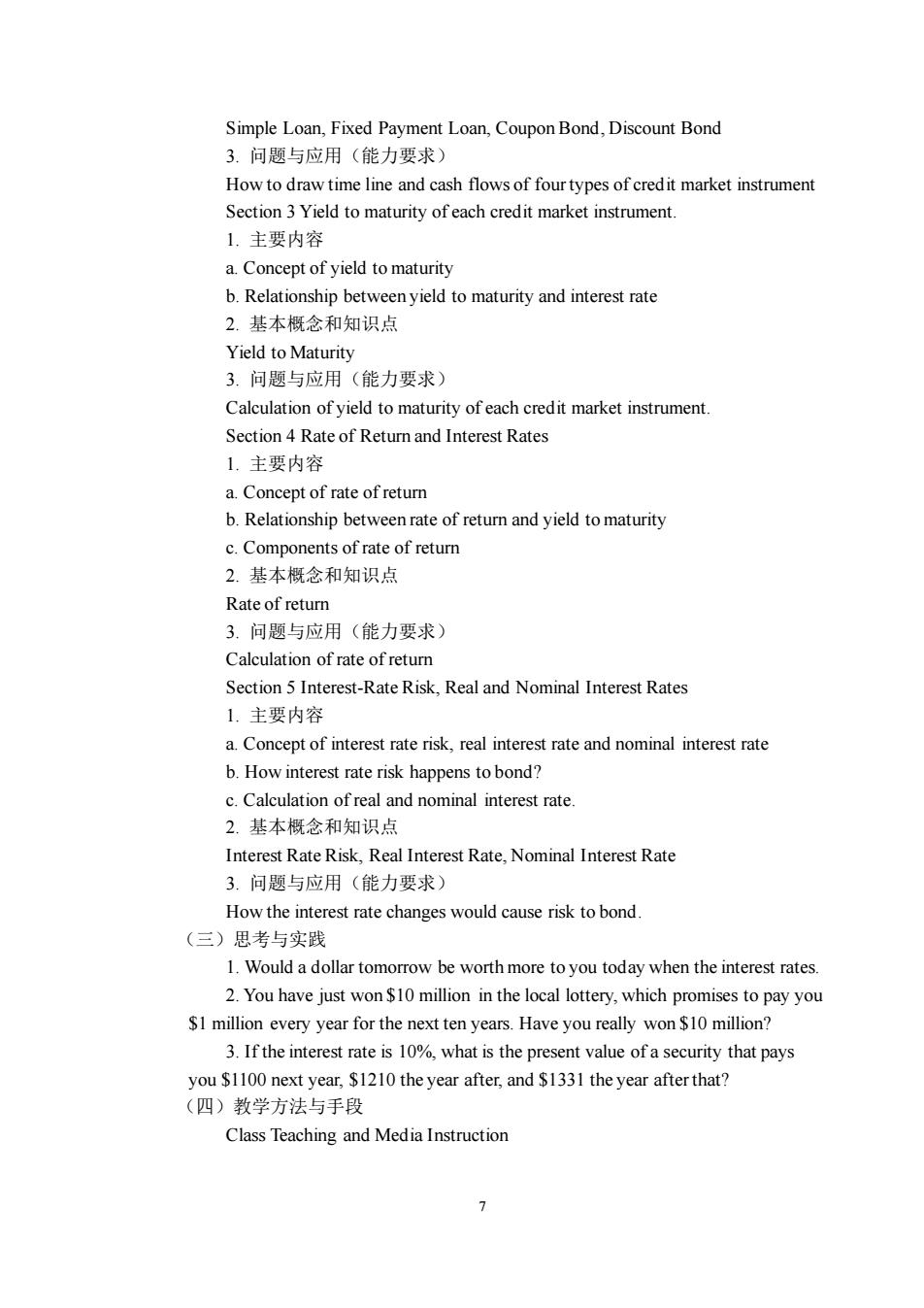
1.Master the concept of money 2.Be familiar with the differences among money,currency,wealth and income. 3.Understand the evolution of the payment system. 4.Master the functions of money. 5.Be familiar with the compositions of monetary aggregates in the U.S (二)教学内容 Section 1 Meaning of Money 1.主要内容 a.What is money? b.Relationship between money and income,currency and wealth. 2.基本概念和知识点 Money,Income,Currency and Wealth 3.问题与应用(能力要求) Difference among concepts and features of money,income,currency and wealth Section 2 Functions of Money 1.主要内容 a.Medium of exchange b.Unit of account c Store of value 2.基本概念和知识点 Medium of exchange,Unit of account,Store of value 3.问题与应用(能力要求) How the three functions differentiate money from other commodity goods. Section 3 Measuring Money 1.主要内容 a.How the money is measured in United States b.How the money is measured in China 2.基本概念和知识点 Demand Deposits,Small Denomination Time Deposits,Savings Deposits, Money Market Deposit Accounts,Money Market Mutual Fund Shares 3.问题与应用(能力要求) Different levels of money and how the money level is defined (三)思考与实践 1.According to the actual data in U.S.,calculate what is the number of MI and M2 in U.S.and discuss what is the changing trend of money supply in U.S. 2.Which of the following three expressions uses the definition of money? a.How much money did you eamn last week? b.When I go to the store,I always make sure that I have enough money
5 1. Master the concept of money. 2. Be familiar with the differences among money, currency, wealth and income. 3. Understand the evolution of the payment system. 4. Master the functions of money. 5. Be familiar with the compositions of monetary aggregates in the U.S. (二)教学内容 Section 1 Meaning of Money 1. 主要内容 a. What is money? b. Relationship between money and income, currency and wealth. 2. 基本概念和知识点 Money, Income, Currency and Wealth 3. 问题与应用(能力要求) Difference among concepts and features of money, income, currency and wealth Section 2 Functions of Money 1. 主要内容 a. Medium of exchange b. Unit of account c. Store of value 2. 基本概念和知识点 Medium of exchange, Unit of account, Store of value 3. 问题与应用(能力要求) How the three functions differentiate money from other commodity goods. Section 3 Measuring Money 1. 主要内容 a. How the money is measured in United States b. How the money is measured in China 2. 基本概念和知识点 Demand Deposits, Small Denomination Time Deposits, Savings Deposits, Money Market Deposit Accounts, Money Market Mutual Fund Shares. 3. 问题与应用(能力要求) Different levels of money and how the money level is defined. (三)思考与实践 1. According to the actual data in U.S., calculate what is the number of M1 and M2 in U.S. and discuss what is the changing trend of money supply in U.S. 2. Which of the following three expressions uses the definition of money? a. How much money did you earn last week? b. When I go to the store, I always make sure that I have enough money

c.The love of money is the root of all evil (四)教学方法与手段 Class Teaching and Media Instruction (五)思政融入点 通过讲解货币制度发展史,使学生充分了解每一种货币制度的优点与缺点 及产生的时代背景,培养学生形成以发展眼光来看问题的理性思维。 Chapter 4 Understanding Interest Rates (一)目的与要求 1.Understand the definition of present value. 2.Understand the goal of introducing the definition of present value 3.Master the method of discounting the future. 4.Be familiar with the definition of time line and its function. 5.Master the features of four types of credit market instrument,and the method to calculate the present value of each instrument. 6.Master the definition of interest rate and its relationship between interest rate and yield to maturity. 7.Master the method of calculating yield to maturity of each credit market instrument. 8.Master the definition of rate ofretum and its relationship withyield to maturity. 9.Be familiar with the definition of interest rate. 10.Master the definition of nominal interest rate and real interest rate. (二)教学内容 Section 1 Present Value and Discounting the Future 1.主要内容 a.Definition and calculation of present value b.Definition and calculation of final value c.Relationship between present value and final value 2.基本概念和知识点 Present Value,Final Value 3.问题与应用(能力要求 The goal of introducing present value Section 2 Four Types of Credit Market Instruments 1.主要内容 a.Different features of four credit market instruments b.Calculations of present values of credit market instruments 2.基本概念和知识点 6
6 c. The love of money is the root of all evil. (四)教学方法与手段 Class Teaching and Media Instruction (五)思政融入点 通过讲解货币制度发展史,使学生充分了解每一种货币制度的优点与缺点 及产生的时代背景,培养学生形成以发展眼光来看问题的理性思维。 Chapter 4 Understanding Interest Rates (一)目的与要求 1. Understand the definition of present value. 2. Understand the goal of introducing the definition of present value. 3. Master the method of discounting the future. 4. Be familiar with the definition of time line and its function. 5. Master the features of four types of credit market instrument, and the method to calculate the present value of each instrument. 6. Master the definition of interest rate and its relationship between interest rate and yield to maturity. 7. Master the method of calculating yield to maturity of each credit market instrument. 8. Master the definition of rate of return and its relationship with yield to maturity. 9. Be familiar with the definition of interest rate. 10. Master the definition of nominal interest rate and real interest rate. (二)教学内容 Section 1 Present Value and Discounting the Future 1. 主要内容 a. Definition and calculation of present value b. Definition and calculation of final value c. Relationship between present value and final value 2. 基本概念和知识点 Present Value, Final Value 3. 问题与应用(能力要求) The goal of introducing present value Section 2 Four Types of Credit Market Instruments 1. 主要内容 a. Different features of four credit market instruments b. Calculations of present values of credit market instruments. 2. 基本概念和知识点

Simple Loan,Fixed Payment Loan,Coupon Bond,Discount Bond 3.问题与应用(能力要求) How to draw time line and cash flows of four types of credit market instrument Section 3 Yield to maturity of each credit market instrument. 1.主要内容 a.Concept of vield to maturity b.Relationship betweenyield to maturity and interest rate 2.基本概念和知识点 Yield to Maturity 3.问题与应用(能力要求) Calculation of yield to maturity of each credit market instrument. Section 4 Rate of Retum and Interest Rates 1.主要内容 a Concept of rate of retum b.Relationship between rate of return and yield to maturity c.Components of rate of retum 2.基本概念和知识点 Rate of retum 3.问题与应用(能力要求》 Calculation of rate of retum Section 5 Interest-Rate risk.real and nominal interest rates 1.主要内容 a.Concept of interest rate risk,real interest rate and nominal interest rate b.How interest rate risk happens to bond? c.Calculation of real and nominal interest rate 2.基本概念和知识点 Interest Rate Risk,Real Interest Rate,Nominal Interest Rate 3.问题与应用(能力要求) How the interest rate changes would cause risk to bond. (三)思考与实践 1.Would a dollar tomorrow be worth more to you today when the interest rates 2.You have just won$10 million in the local lottery,which promises to pay you $1 million every year for the next ten years.Have you really won$10 million? 3.If the interest rate is 10%,what is the present value of a security that pays you $1100 next year,$1210 the year after,and $1331 the year afterthat? (四)教学方法与手段 Class Teaching and Media Instruction 7
7 Simple Loan, Fixed Payment Loan, Coupon Bond, Discount Bond 3. 问题与应用(能力要求) How to draw time line and cash flows of four types of credit market instrument Section 3 Yield to maturity of each credit market instrument. 1. 主要内容 a. Concept of yield to maturity b. Relationship between yield to maturity and interest rate 2. 基本概念和知识点 Yield to Maturity 3. 问题与应用(能力要求) Calculation of yield to maturity of each credit market instrument. Section 4 Rate of Return and Interest Rates 1. 主要内容 a. Concept of rate of return b. Relationship between rate of return and yield to maturity c. Components of rate of return 2. 基本概念和知识点 Rate of return 3. 问题与应用(能力要求) Calculation of rate of return Section 5 Interest-Rate Risk, Real and Nominal Interest Rates 1. 主要内容 a. Concept of interest rate risk, real interest rate and nominal interest rate b. How interest rate risk happens to bond? c. Calculation of real and nominal interest rate. 2. 基本概念和知识点 Interest Rate Risk, Real Interest Rate, Nominal Interest Rate 3. 问题与应用(能力要求) How the interest rate changes would cause risk to bond. (三)思考与实践 1. Would a dollar tomorrow be worth more to you today when the interest rates. 2. You have just won $10 million in the local lottery, which promises to pay you $1 million every year for the next ten years. Have you really won $10 million? 3. If the interest rate is 10%, what is the present value of a security that pays you $1100 next year, $1210 the year after, and $1331 the year after that? (四)教学方法与手段 Class Teaching and Media Instruction